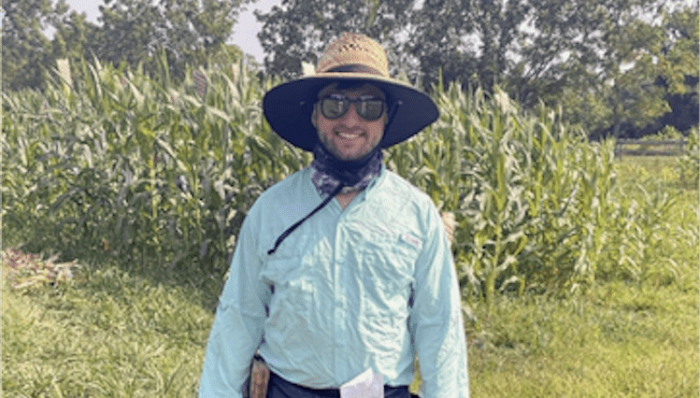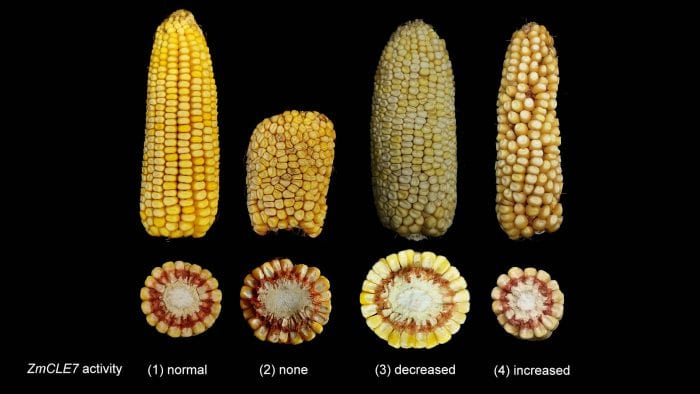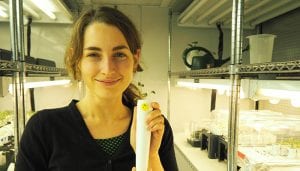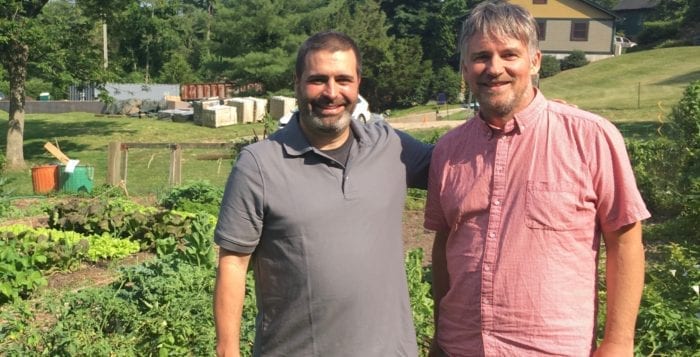By Daniel Dunaief
Farmers typically plant the sweet corn that fills Long Islander’s table some time between late April and June, with flavorful yellow kernels ready to eat about eight weeks later.
But what if corn, which is planted and harvested on a typical annual crop schedule, were perennial? What if farmers could plant a type of corn that might have deeper roots, would become dormant in the winter and then grew back the next year?
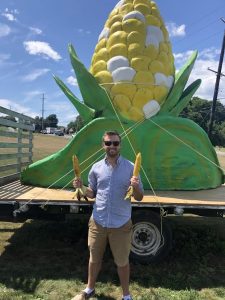
Cold Spring Harbor Laboratory postdoctoral researcher Kyle Swentowsky, working in the lab of Professor Dave Jackson, is interested in the genetics of perennial grasses, which includes maize, wheat, rice, barley, sorghum and others. He uses maize as a model.
Extending the work he did as part of his PhD research at the University of Georgia, Swentowsky, who arrived at CSHL in July of 2021, is searching for the genes that cause the major differences between annual and perennial grasses.
Kelly Dawe, who was Swentowsky’s PhD advisor, described him as “passionate” “diligent” and “thoughtful.” Dawe explained that perennials have been beneficial in the farming of other crops. Perennial rice has enabled farmers to save 58.1 percent on labor costs and 49.2 percent on input costs with each regrowth cycle, Dawe explained, adding, “The rice work is much farther along, but could have a similar impact on corn.”
Aside from producing crops over several years without requiring replanting, perennial corn also has several other advantages. Perennials, which have deeper roots, can grow in soil conditions that might not be favorable for annual crops, which can help stabilize the soil and expand the range of farmable land.
Recently, people have also considered how scientists or farmers might take some of the sub-properties of perennials and apply them to annual crops without converting them to perennials. Some annuals with perennial traits might stay green for longer, which means they could continue the process of photosynthesis well after annuals typically stop.
A complex challenge
Scientists have been trying to make perennial corn for about 50 years. The perennial process is not as simple as other plant traits.
“We don’t understand all the underlying sub properties of being perennial,” Swentowsky said. “It’s very complicated and involves a lot of regions in the genome. My work aims to get at some of these sub traits and genomic loci that are involved in this process.”
In his work, Swentowsky is interested in the sub traits that the major genes control. He expects that a reliable perennial corn wouldn’t make the annual variety obsolete. Even after researchers develop an effective perennial corn, farmers may still cultivate it as an annual in some environments.
In the bigger picture, Swentowsky, like other plant researchers at CSHL and elsewhere around the world, recognizes the challenge of feeding a population that will continue to increase while climate change threatens the amount of arable land.
Plant breeders need to continue to come up with ways to increase crop yield to boost food production, he suggested. While some people have considered dedicating resources to back up plans like astro-botany — or growing crops in space — Swentowsky suggested this was challenging and urged ongoing efforts to produce more food on Earth.
Impressed with the way Matt Damon’s character in the movie The Martian farms potatoes on the Red Planet, Swentowsky suggested that such an agricultural effort would be challenging on a large scale in part because of the extreme temperature variations.
As for work on Earth, perennial corn may also remove more carbon dioxide from the air, reducing the presence of greenhouse gases such as carbon dioxide.
Swentowsky cautioned that the idea of carbon farming is still relatively new and researchers don’t know what would make a good carbon farming plant yet. At this point, his work has involved breeding and back crossing corn plants. Once he develops a better idea of what genes are involved in the perennial life cycle, he will consider taking a trans-genetic approach or use the gene editing tool Crispr to test the effects of the involved genes.
Swentowsky expects that several genetic changes may be necessary to develop a perennial plant. He and others have mapped the master regulators of perenniality to three major genes. He believes it’s likely that dozens or even hundreds of other genes scattered throughout the genome play a small role influencing perennial sub-traits.
California roots
A current resident of Long Beach, Swentowsky grew up in Sacramento, California. He earned his undergraduate and master’s degrees at the University of California at Santa Barbara. After six years, he was “tired of perfect weather,” he laughed. He would sweat through football games in January, when it was 80 degrees amid a cloudless sky.
As an undergraduate, he took a plant development course and appreciated the elegant way scientists tested plants. His two favorite scientists are Gregor Mendel, whose pioneering pea work led to the field of modern genetics, and Barbara McClintock, a former CSHL scientist whose Nobel Prize winning research on corn led to an understanding of transposable elements, or jumping genes in which genes change position on a chromosome.
Outside of the lab, Swentowsky enjoys traveling, including camping and backpacking, spending time on the beach, attending reggae, alternative, classic rock, hip hop and electric concerts and going to breweries. During the winter, his favorite beers are stout and porter. In warmer weather, he imbibes sour IPA.
Swentowsky doesn’t just study corn: he also enjoys eating it. One of his favorites is elote, or Mexican street corn. He grills the corn on a barbecue, covers it with mayonnaise and cotija cheese and sprinkles lyme or chili powder on it.
Swentowsky, who is funded through the summer of 2025 at CSHL, appreciates the opportunity to contribute to work that could support future farming efforts. He hopes that studying perenniality in corn could have future applications.

